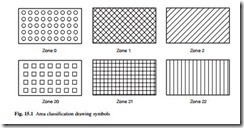Codes of practice for area classification
Codes of practice for area classification usually recommend that area classification is carried out by a team which includes the electrical/control function. Electrical engineers working in industries within the scope of DSEAR should, therefore, have some familiarity with the process of area classification and its meaning. The codes of practice fall into three broad categories; those which deal with principles, those dealing with industry sectors and those covering specific companies, installations or flammable materials. There are too many codes of practice to include in an exhaustive list but the more common ones are mentioned here. Dealing with area classification principles are BS EN 60079-10:2003 (reference 15L) for gases and vapours, and BS EN 50281-3:2002 (reference 15M) for combustible dust. One of the most common industry codes of practice is the Institute of Petroleum Code (reference 15N) which covers gases, vapours and mists. Specific codes of practice include IGE/SR/25 (reference 15O) for natural gas installations and various codes of practice and guidance from the British Compressed Gases Association covering the storage, handling and use of compressed gases in transportable cylinders.
The process of area classification includes the following:
A. Identify all materials which are capable of forming a potentially explosive atmosphere in the conditions of use, including both normal and abnormal process conditions
B. Identify the actual and potential sources of release of those materials
C. Grade the sources of release according to the probability of the release forming a potentially explosive atmosphere (see Table 15.1)
D. Consider the effect of ventilation on the releases to determine the resulting zones and their extents (see Table 15.2)
E. Document the results in a report and produce area classification drawings (see Fig. 15.1)
Notes: (a) Zone 0 NE, 1 NE or 2 NE indicates a theoretical zone which would be of negligible extent under normal conditions
(b) The zone 2 area created by a secondary grade of release may exceed that attributable to a primary or contin case, the greater distance should be taken.
(c) Will be zone 0 if the ventilation is so weak and the release is such that in practice an explosive gas atmosphere e (i.e. approaching a ‘no ventilation’ condition).
(d) A ‘Medium’ degree of ventilation with ‘Good’ availability is equivalent to an outdoor location.
(e) ‘+’ denotes ‘surrounded by’.
(f) The definitions of ‘degree’ and ‘availability’ of ventilation are given in BS EN 60079-10:2002. Table 15.2 applies to gases and


